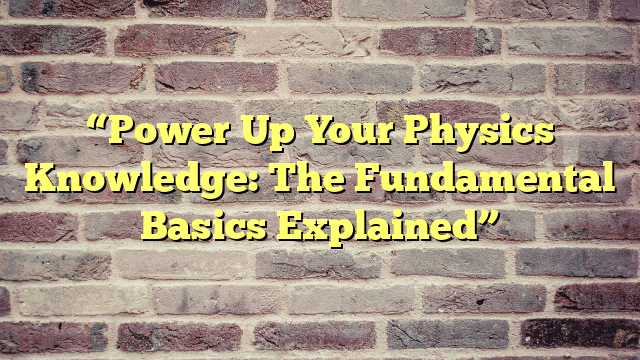Power Up Your Physics Knowledge: The Fundamental Basics Explained
Physics is a fundamental branch of science that deals with the study of matter, energy, and their interactions. It is a subject that is often considered challenging and intimidating, but with a strong foundation in its fundamental concepts, it can become an intriguing and fascinating subject. In this article, we will explore the fundamental basics of physics, breaking them down into simpler terms and providing examples to help you understand them better. So let’s dive in and power up your physics knowledge!
1. What is Physics?
Focus Keyword: Physics
Physics is the study of the natural world and its laws. It is concerned with understanding the fundamental principles that govern the behavior of matter and energy, from the smallest subatomic particles to the vast expanses of the universe. The word “physics” comes from the Greek word “physis,” which means nature. It is one of the oldest academic disciplines and has played a crucial role in shaping our understanding of the world.
2. Newton’s Laws of Motion
Focus Keyword: Newton’s Laws of Motion
One of the most fundamental concepts in physics is Newton’s Laws of Motion. These laws were first presented by Sir Isaac Newton in the late 17th century and laid the foundation for classical mechanics. The three laws are as follows:
– First Law: An object at rest will remain at rest, and an object in motion will continue in a straight line at a constant speed unless acted upon by an external force.
– Second Law: The acceleration of an object is directly proportional to the net force acting on it and inversely proportional to its mass. This law can be expressed as F=ma, where F is the force, m is the mass, and a is the acceleration.
– Third Law: For every action, there is an equal and opposite reaction. This means that when one body exerts a force on another, the second body will exert an equal and opposite force on the first body.
These laws are essential in understanding the motion of objects and are the basis for many other principles in physics.
3. The Law of Conservation of Energy
Focus Keyword: Law of Conservation of Energy
Energy is a fundamental concept in physics, and the Law of Conservation of Energy states that energy cannot be created or destroyed, only transferred from one form to another. This law is also known as the First Law of Thermodynamics and is essential in understanding various phenomena, such as the conversion of potential energy to kinetic energy in a falling object or the conversion of electrical energy to light energy in a light bulb.
4. Forces and Their Types
Focus Keyword: Forces
A force is any influence that causes an object to undergo a change in motion. There are four fundamental forces in nature: gravitational, electromagnetic, strong nuclear, and weak nuclear. The gravitational force is responsible for the attraction between masses, while the electromagnetic force is responsible for the interaction between charged particles. The strong nuclear force is responsible for holding the nucleus of an atom together, and the weak nuclear force is responsible for radioactive decay. Understanding these forces is crucial in understanding how objects behave and interact with each other.
5. Work, Power, and Energy
Focus Keyword: Work, Power, and Energy
Work, power, and energy are closely related concepts in physics. Work is the transfer of energy that occurs when a force is applied to an object and causes it to move. Power is the rate at which work is done, while energy is the ability to do work. These concepts are essential in understanding the efficiency of machines and other systems.
6. Motion and Its Types
Focus Keyword: Motion
Motion is the change in position of an object with respect to time. There are three types of motion: translational, rotational, and vibrational. Translational motion is when an object moves in a straight line, rotational motion is when an object rotates around an axis, and vibrational motion is when an object moves back and forth around a fixed point. Understanding these types of motion is crucial in understanding the behavior of objects in the physical world.
7. Waves and Their Properties
Focus Keyword: Waves and Their Properties
Waves are disturbances that transfer energy from one place to another without the transfer of matter. They can be classified into two types: mechanical and electromagnetic. Mechanical waves require a medium to travel through, while electromagnetic waves can travel through a vacuum. Some of the properties of waves include amplitude, wavelength, frequency, and speed. Waves are an essential concept in understanding various phenomena, such as sound, light, and seismic waves.
Conclusion
In conclusion, physics is a vast and fascinating subject that is the basis for understanding the natural world. It is essential to have a strong foundation in its fundamental concepts to excel in the subject. In this article, we have explored some of the fundamental basics of physics, including Newton’s Laws of Motion, the Law of Conservation of Energy, forces, work, power, energy, motion, and waves.

